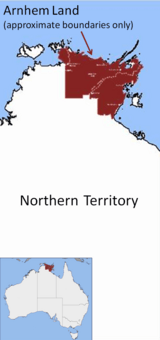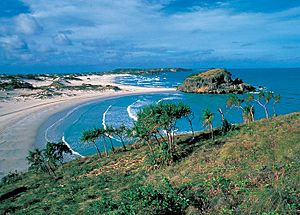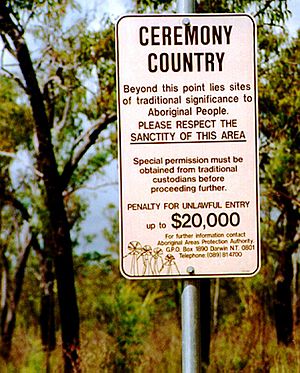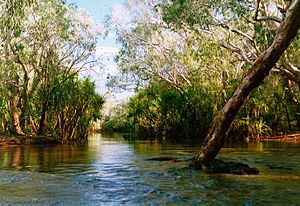Arnhem Land facts for kids
Quick facts for kids Arnhem LandNorthern Territory |
|
|---|---|

Approximate location of Arnhem Land
|
|
| Population | 16,230(2007) |
| • Density | 0.1673/km2 (0.433/sq mi) |
| Area | 97,000 km2 (37,451.9 sq mi) |
| Territory electorate(s) | Arafura, Nhulunbuy, Arnhem |
| Federal Division(s) | Lingiari |
Arnhem Land is a large, special region in the Northern Territory of Australia. It is located in the northeast part of the territory. This area is about 500 kilometers (310 miles) from Darwin, the capital city.
Arnhem Land covers a huge area of 97,000 square kilometers (37,000 square miles). This vast region also includes parts of Kakadu National Park. Around 16,230 people live in Arnhem Land. The region was named by Matthew Flinders. He named it after the Dutch ship Arnhem, which explored the coast in 1623.
Contents
Geography of Arnhem Land
Arnhem Land stretches from Port Roper on the Gulf of Carpentaria. It goes along the coast to the East Alligator River. This is where it meets Kakadu National Park.
Some of the main towns in Arnhem Land are Jabiru, Maningrida, and Nhulunbuy. Jabiru is right on the edge of Kakadu National Park. Maningrida is located at the mouth of the Liverpool River.
Nhulunbuy is in the far northeast. It is also known as Gove. This town is home to a large mine that digs up bauxite. Bauxite is a rock used to make alumina, which is then used to make aluminum. Nhulunbuy is the fourth largest town in the Northern Territory.
Climate and Weather
The weather in Arnhem Land is tropical. It has two main seasons: a wet season and a dry season. Temperatures do not change much throughout the year.
During the dry season, from April to September, nights can get as cool as 15 degrees Celsius (59°F). In the wet season, from October to March, days can be as hot as 33 degrees Celsius (91°F). This is when the region gets most of its rain.
The People of Arnhem Land
Arnhem Land became an Aboriginal Reserve in 1931. It is still one of Australia's largest Aboriginal Reserves today. The region is known for being remote and for its amazing art. It is also famous for the strong traditions of its people.
The northeast part of Arnhem Land is home to the Yolngu people. They are one of the largest groups of Indigenous Australians. The Yolngu have done a great job of keeping their traditional culture alive.
Long ago, before Europeans arrived, people from Malaysia and Macassar (in Indonesia) visited the coastal Aboriginal groups. They traded with them.
The 2006 movie Ten Canoes shows what life is like in Arnhem Land. It tells a story using old Aboriginal tales. One of the actors also helped direct the movie. This film, and another one called The Balano and the Bark Canoes, show how hard the Indigenous people have worked to keep their culture strong.
Amazing Art of Arnhem Land
The Aboriginal town of Yirrkala is just outside Nhulunbuy. It is famous around the world for its bark paintings. Yirrkala has also played a big role in fighting for the rights of Indigenous Australians. This town is also where the Yidaki, or Didgeridoo, first came from.
Another town, Gunbalanya (once called Oenpelli), in Western Arnhem Land, is also well-known for its beautiful bark paintings.
Arnhem Land is especially famous for its ancient Aboriginal rock art. Some of the best examples can be seen at Ubirr Rock, Injalak Hill, and in the Canon Hill area.
Some of these rock paintings show early visits by Europeans. They are so detailed that you can even see Martini-Henry rifles! Other paintings show axes, aircraft, and ships. In one rock shelter, far from Darwin, there is a painting of the wharf at Darwin. It shows buildings, boats, and Europeans with their hats and pipes. Some are even shown with their hands in their pockets!
Near the East Alligator River crossing, there is a painting of a man with a gun and long pigtails. This person was likely one of the Chinese workers who came to Darwin in the late 19th century. The people also create special ritual sand sculptures, but these do not last long.
One stone arrangement made by the Yolngu people is at Maccasans Beach near Yirrkala. It shows how the Macassan praus (ships) were arranged for Trepang fishing. The Yolngu people traded with the people of Makassar on the Indonesian island of Sulawesi. This trading happened 200 years before Europeans settled in Australia.
Related pages
Images for kids
-
Yolngu man Timmy Burarrwanga at Bawaka
-
Glen Namundja, an Australian Aboriginal artist from Arnhem Land, at work
-
Timmy 'Djawa' Burarrwanga pointing out fish in Yalangbara
See also
 In Spanish: Tierra de Arnhem para niños
In Spanish: Tierra de Arnhem para niños









